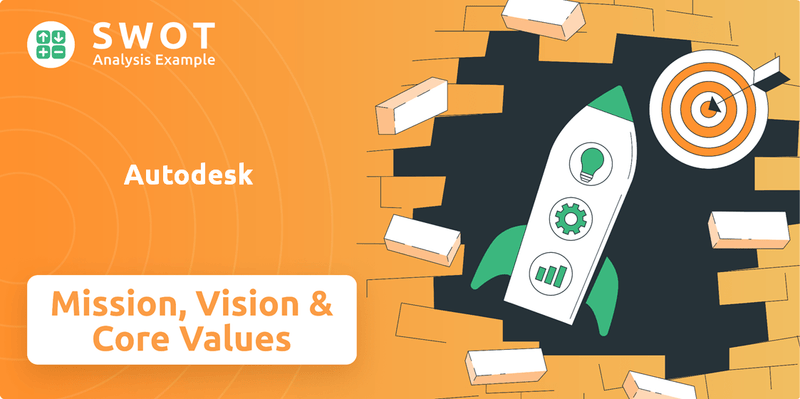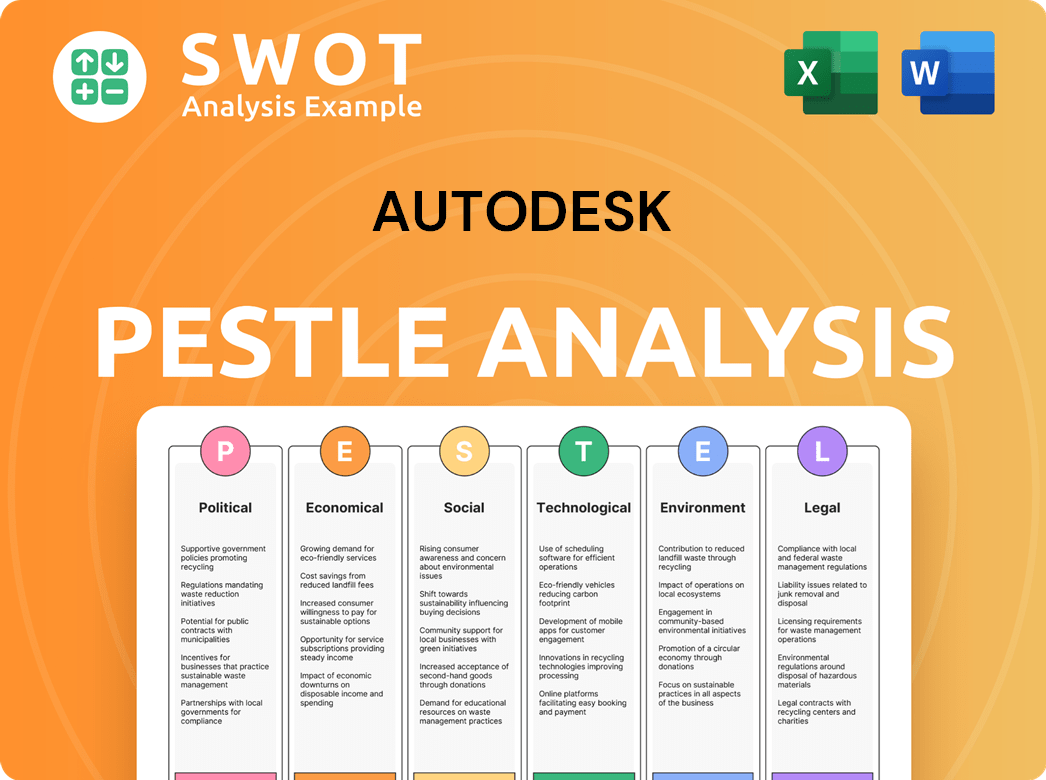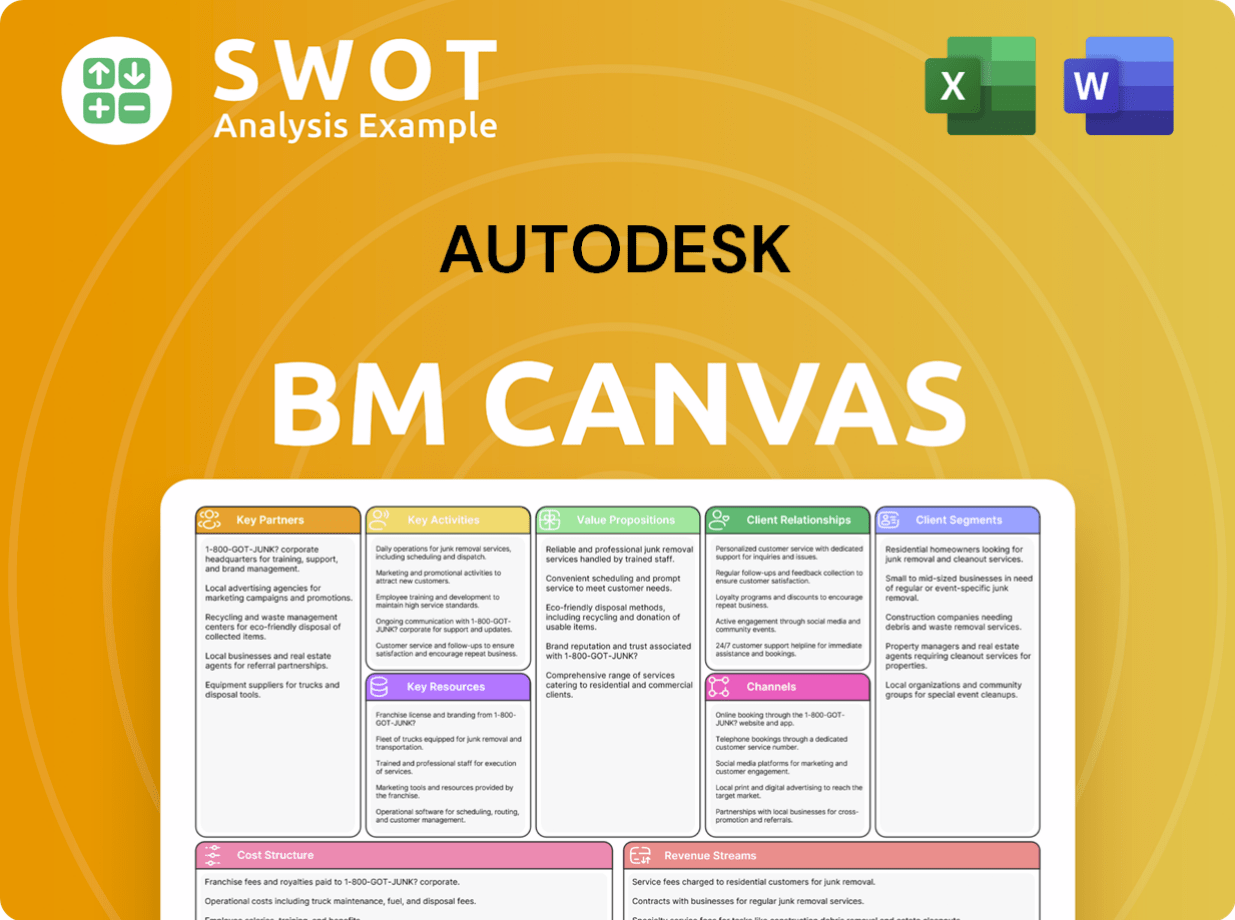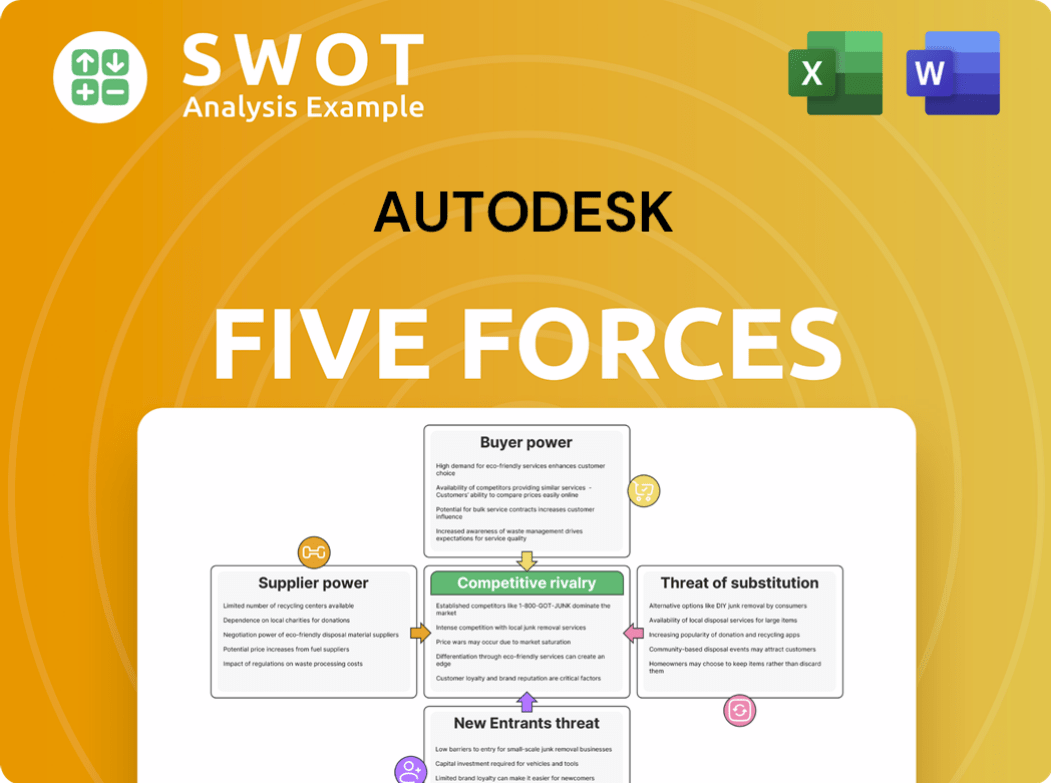Autodesk Bundle
What Drives Autodesk's Success: Mission, Vision, and Values?
Understanding a company's core principles is key to grasping its trajectory, and for Autodesk, a design and make software giant, these principles are paramount. They shape the company's identity and guide its every move in the competitive tech landscape.

Autodesk's Autodesk SWOT Analysis underscores the importance of these foundational elements. Delving into the Autodesk mission, Autodesk vision, and Autodesk core values provides a vital lens through which to view its strategic direction, business goals, and overall Autodesk culture. Examining these elements helps us understand how a global leader like Autodesk navigates the complexities of innovation and market dynamics.
Key Takeaways
- Autodesk's mission, vision, and values are central to its corporate identity and strategic direction.
- A clear focus on empowering innovators and transforming industries through digital solutions drives Autodesk's actions.
- Values like unity, optimism, and trust shape a strong corporate culture and influence strategic choices.
- Autodesk's commitment to AI, sustainability, and addressing industry talent gaps is crucial for future relevance.
- The company's purpose extends beyond software, aiming to build a more sustainable and efficient future.
Mission: What is Autodesk Mission Statement?
Autodesk's mission is 'to empower everyone, everywhere to design and make anything.'
Let's delve into the core of Autodesk's purpose and how it shapes its operations.
The Autodesk mission statement is a powerful declaration of intent. It's a broad, inclusive statement that guides the company's actions and strategic direction. This mission statement is the foundation upon which Autodesk builds its products, services, and overall strategy.
The mission's key components include empowering innovators, providing design and make technology, and solving complex challenges across industries. This encompasses a wide array of users, from architects and engineers to digital artists and manufacturers. Understanding these components helps to analyze the Autodesk goals and how they are achieved.
Autodesk's commitment to its mission is evident in its product development. For instance, the integration of AI-powered features in AutoCAD and Revit demonstrates a focus on innovation. This is a direct reflection of the Autodesk vision to provide cutting-edge tools.
Autodesk's financial investments underscore its mission. In fiscal year 2024, the company invested $1.708 billion in research and development. This significant investment is crucial for staying at the forefront of technological advancements, directly supporting its mission. This also impacts the Autodesk culture.
Autodesk's mission drives solutions for specific industry challenges. Promoting Building Information Modeling (BIM) in the AEC industry is an example of how the company aims to streamline project delivery and reduce costs. This approach highlights the Autodesk mission's impact.
The mission is fundamentally customer-centric and innovation-focused. It aims to provide tools that enable users to bring their ideas to life and transform industries. This approach is critical when considering the Competitors Landscape of Autodesk.
Understanding the Autodesk mission statement examples provides insight into how the company operates. The mission statement is not just a set of words; it is a driving force behind Autodesk's actions, product development, and overall strategy. It is a key element in understanding Autodesk's vision for the future and its commitment to empowering users across various industries. The Autodesk mission and its impact can be seen in its dedication to innovation and customer empowerment.
Autodesk SWOT Analysis
- Complete SWOT Breakdown
- Fully Customizable
- Editable in Excel & Word
- Professional Formatting
- Investor-Ready Format

Vision: What is Autodesk Vision Statement?
Autodesk's vision is to "Imagine, design, and make a better world."
Let's delve into the core of what drives Autodesk, exploring its vision and how it shapes the company's direction. Understanding the Autodesk vision is crucial for grasping its long-term goals and strategic initiatives. This vision is not just a statement; it's a guiding principle that influences every aspect of the Autodesk company, from product development to market strategy.
At the heart of the Autodesk vision lies the commitment to empower innovators. This means providing designers, engineers, and creators with the tools they need to bring their ideas to life. The company aims to be the leading provider of software solutions that enable the creation of innovative designs.
Autodesk seeks to drive digital transformation across key industries. This involves helping sectors like architecture, engineering, construction (AEC), manufacturing, and media and entertainment embrace digital workflows. The goal is to improve efficiency, collaboration, and innovation within these industries.
A significant aspect of Autodesk's vision is its focus on sustainable design. The company promotes environmentally responsible practices and provides tools for analyzing and optimizing environmental impact. This emphasis reflects a growing awareness of the importance of sustainability in design and manufacturing.
Autodesk's vision is supported by substantial investments in research and development. In fiscal year 2024, the company invested approximately $1.7 billion in R&D. This commitment to innovation is crucial for maintaining its competitive edge and advancing its vision. The company's commitment to innovation and investment is a key component of its long-term strategy.
Autodesk's vision is closely tied to its cloud-based services and subscription model. This approach allows for greater flexibility, collaboration, and access to the latest software updates. The shift to a subscription model has been a key driver of revenue growth, with subscription revenue representing a significant portion of total revenue.
Autodesk's vision extends to addressing global challenges through its software solutions. By promoting sustainable design practices and enabling innovation in various industries, the company aims to contribute to a better future. This includes supporting initiatives related to climate change, resource efficiency, and urban development.
The Autodesk vision is ambitious and forward-looking, focusing on empowering creators, transforming industries, and promoting sustainable design. This vision is supported by significant investments in research and development, a strong commitment to cloud-based services, and a focus on addressing global challenges. To understand the company's origins and evolution, you can read more in our Brief History of Autodesk. The company's Autodesk goals are directly aligned with its vision, and the Autodesk core values serve as the foundation for achieving these goals. Understanding the Autodesk mission and how it aligns with the vision provides a comprehensive view of the company's strategic direction. The Autodesk culture is also shaped by these values, fostering a collaborative and innovative environment.
Autodesk PESTLE Analysis
- Covers All 6 PESTLE Categories
- No Research Needed – Save Hours of Work
- Built by Experts, Trusted by Consultants
- Instant Download, Ready to Use
- 100% Editable, Fully Customizable

Values: What is Autodesk Core Values Statement?
Autodesk's core values are the bedrock of its corporate culture, guiding its actions and decisions across all facets of its operations. These values, encapsulated in the "One ORBIT" acronym, shape Autodesk's identity and its approach to innovation, customer relations, and employee engagement.
This value emphasizes collaboration and unity throughout the organization, fostering a cohesive environment where employees work together to achieve common goals. This is evident in their integrated cloud-based platforms like Fusion 360 and Autodesk Construction Cloud, which promote seamless data connectivity. Autodesk's commitment to being 'One Autodesk' is reflected in its consolidated financial performance, with a reported revenue of $5.5 billion in fiscal year 2024, demonstrating the effectiveness of its unified approach.
Autodesk embraces optimism by believing in continuous improvement and seeking innovative solutions. This value drives the exploration of emerging technologies, such as AI, to enhance user capabilities and create more efficient workflows, aligning with their vision for the future. The company's investment in generative design and AI tools, with over 100 AI-powered features integrated into their products, showcases their optimistic approach to innovation.
Autodesk demonstrates its relentless pursuit of results through continuous product updates and the exploration of cutting-edge technologies. This drive is evident in the company’s consistent revenue growth and market leadership. The company's dedication to customer success is reflected in its high customer retention rates, with approximately 90% of its revenue being recurring, highlighting its relentless focus on delivering value.
Autodesk's bravery is shown through its willingness to take smart risks and make bold decisions, such as the transition to a subscription-based model. This value fosters an environment where employees are encouraged to challenge assumptions and innovate. This strategic shift has significantly contributed to the company's financial stability and growth, with subscription revenue accounting for over 95% of its total revenue in recent years, as discussed in Growth Strategy of Autodesk.
These core values are integral to Autodesk's identity, shaping its approach to innovation, customer success, and corporate responsibility. Understanding these values provides a deeper insight into how Autodesk operates and achieves its goals, influencing its mission and vision. Now, let's explore how these core values influence the company's strategic decisions, as we delve into the next chapter on mission and vision.
How Mission & Vision Influence Autodesk Business?
Autodesk's mission and vision are not just aspirational statements; they are the very foundation upon which the company builds its strategic roadmap. These guiding principles directly influence key decisions, shaping its products, services, and overall market approach.
Autodesk's mission, "to help everyone, everywhere, design and make anything," and its vision of transforming industries, are the cornerstones of its strategic direction. These principles guide the company's actions, influencing everything from product development to market expansion. Here are four key examples:
- Transition to Subscription Model: Autodesk's shift to a subscription-based model, starting in 2016, aligned with its vision of providing flexible access and fostering collaboration. This strategic move resulted in a more predictable revenue stream and deeper customer engagement. In fiscal year 2024, subscription revenue was $1.36 billion, representing 93% of total revenue.
- Investment in Cloud-Based Platforms and AI: The company's heavy investment in cloud-based platforms like Fusion 360 and Autodesk Construction Cloud, along with the Forge development platform, directly supports its vision of transforming industries. This commitment is further bolstered by significant R&D spending, which totaled $1.708 billion in fiscal year 2024, with a strong focus on AI and machine learning. The 2025 Fusion Roadmap highlights a focus on cloud data, collaboration, and AI.
- Emphasis on Sustainable Design: Autodesk actively promotes sustainable design practices and solutions, integrating sustainable design principles into its software. This aligns with its vision of 'Sustainable Design' and its belief in 'making a better world.' In 2024, Autodesk achieved carbon neutrality in its operations and has reduced its emissions by 41% since 2009. The FY24 Impact Report outlines their progress against sustainability goals.
- Strategic Acquisitions for Industry Leadership: Autodesk has strategically acquired key technologies, such as Revit, to transform from a CAD company into a diversified leader. This supports its mission to empower innovators across various sectors and its vision to transform industries. Recent acquisitions like Aether Media, Inc., and Payapps Limited in Q4 2024 aim to enhance capabilities in AI and construction payment management.
Autodesk's mission and vision are not just abstract concepts; they actively shape day-to-day operations and long-term planning. The focus on sustainability, for instance, influences immediate product development, with new tools for embodied carbon calculation and AI-assisted design released in 2024. The company's leadership consistently reinforces these themes.
CEO Andrew Anagnost emphasizes the importance of technology as a catalyst for progress, stating that Autodesk's mission drives the development of solutions to tackle the world's biggest challenges. This commitment is reflected in the company's actions and strategic decisions.
The alignment of Autodesk's actions with its mission and vision is evident in its measurable success metrics. Recurring revenue, which represented 98% of total revenue in fiscal year 2024, demonstrates strong customer engagement. The AEC segment revenue grew by 13% and the manufacturing segment by 11% in fiscal year 2024, indicating the increasing adoption of their solutions, driven by digital transformation efforts.
Autodesk's mission and vision directly influence the company's goals, driving innovation and market leadership. By focusing on its core values, Autodesk continues to shape the future of design and engineering. Understanding the Mission, Vision & Core Values of Autodesk is crucial for grasping the company's strategic direction.
Autodesk's core values are deeply embedded in its culture, influencing how employees work and collaborate. These values guide decision-making and foster a shared sense of purpose, contributing to a positive and productive work environment. This culture is essential for achieving the company's vision and mission.
The importance of Autodesk's core values cannot be overstated. They serve as a compass, guiding the company's actions and ensuring that all initiatives align with its mission and vision. These values are the foundation of Autodesk's success and its ability to innovate and adapt to the evolving needs of its customers.
In conclusion, Autodesk's mission and vision are not merely symbolic; they are the driving forces behind its strategic decisions, influencing everything from product development to market expansion. The company's commitment to innovation, sustainability, and customer-centricity, all rooted in its core values, positions it for continued success. Ready to explore how Autodesk can improve? Let's dive into the next chapter: Core Improvements to Company's Mission and Vision.
Autodesk Business Model Canvas
- Complete 9-Block Business Model Canvas
- Effortlessly Communicate Your Business Strategy
- Investor-Ready BMC Format
- 100% Editable and Customizable
- Clear and Structured Layout

What Are Mission & Vision Improvements?
While Autodesk's current statements are comprehensive, there are opportunities to refine them for greater impact and alignment with evolving industry trends. These improvements aim to strengthen Autodesk's mission, vision, and core values, ensuring continued relevance and leadership in the design and make industries.
Autodesk’s mission and vision statements, while thorough, could benefit from more succinct phrasing. This would make them more memorable and easier to communicate, resonating more effectively with both internal teams and external stakeholders. Streamlining the language ensures the core message, such as Autodesk's mission, is easily grasped and retained.
Explicitly incorporating 'data intelligence' into the Autodesk mission or vision is crucial, given the growing importance of data interoperability and AI-driven insights. The 2025 State of Design & Make report highlights that data-effective organizations are more confident, and this emphasis would better reflect Autodesk's role in the future of design. This also aligns with the company's focus on empowering users and transforming industries, a key aspect of Autodesk's vision.
Autodesk's influence extends beyond direct customers to a vast ecosystem of partners, developers, and educational institutions. A more explicit mention of fostering a collaborative external ecosystem within the vision could emphasize their role in driving industry-wide progress, aligning with their efforts to lead global coalitions. This could be a key element in communicating Autodesk's core values.
As technologies like generative AI mature, the vision could articulate a clearer, more tangible future outcome specifically enabled by these advancements. Instead of focusing solely on AI as a tool, the vision could speak to the transformative human-AI co-creation experience or the acceleration of innovation it enables. For example, the company can improve its target market by showcasing how it can reach new customers.
How Does Autodesk Implement Corporate Strategy?
Implementing a company's mission, vision, and core values is crucial for translating aspirational statements into tangible actions and outcomes. This chapter explores how Autodesk, a leading design and software company, effectively implements its guiding principles across its operations and strategic initiatives.
Autodesk demonstrates its commitment to its Autodesk mission of 'empowering everyone, everywhere to design and make anything' through its cloud-based services and subscription model. This approach provides flexible access to design tools and fosters collaboration among users globally.
- Subscription Revenue: In fiscal year 2024, subscription revenue accounted for 93% of Autodesk's total revenue, highlighting the success of this model.
- Accessibility: Cloud-based tools make powerful design software more accessible to a wider audience, supporting the mission.
- Collaboration: Cloud platforms facilitate real-time collaboration, enhancing design workflows.
- Flexibility: Subscription models offer flexible payment options, catering to diverse user needs.
Autodesk's substantial investment in research and development (R&D) is a direct implementation of its commitment to innovation and empowering innovators. This investment fuels the development of cutting-edge technology, supporting the company's Autodesk vision for the future.
R&D Expenditure: Autodesk invested $1.708 billion in R&D in fiscal year 2024, demonstrating a strong commitment to innovation.
Leadership plays a critical role in reinforcing Autodesk's mission, vision, and Autodesk core values throughout the organization. CEO Andrew Anagnost consistently articulates how the company's mission drives the development of solutions for global challenges.
Culture Code: The company's 'Culture Code' and 'One ORBIT' values (One Autodesk, Optimistic, Relentless, Brave, Trusted) guide employee behavior and interactions.
Autodesk communicates its mission and vision to all stakeholders through various channels, including annual reports and investor conferences. These platforms showcase the company's progress against its goals and strategic direction.
Impact Reports: The FY25 Impact Report details Autodesk's progress on sustainability goals and ESG indicators.
Autodesk actively integrates sustainable design principles into its software, providing tools for analyzing environmental impact and optimizing resource use. This directly supports its vision of sustainable design and contributes to a better world.
Operational Carbon Neutrality: Autodesk achieved operational carbon neutrality in 2024, demonstrating its commitment to environmental sustainability.
Autodesk's investment in AI and its focus on customer experience exemplify its core values and commitment to innovation. The integration of AI into products enhances user productivity, while a customer-centric approach ensures user needs are met.
- AI Integration: Integration of AI into products like Fusion 360 enhances user productivity. The 2025 State of Design & Make report highlights that 39% of leaders are using AI to be more sustainable.
- Customer Experience: Autodesk is committed to providing an exceptional customer experience, ensuring every employee understands their role in customer success.
Autodesk utilizes formal programs and systems to ensure alignment with its values, including ESG initiatives and support for educational programs. These initiatives demonstrate a commitment to social responsibility and sustainable practices.
ESG Initiatives: ESG initiatives, detailed in annual reports, showcase efforts to minimize carbon emissions and promote responsible resource management.
Autodesk supports programs like Stacks and Joules, which address the growing skills gap in green building operator careers. This aligns with their mission to empower innovators and contribute to a better world. To understand how Autodesk generates revenue and operates, read this article about Revenue Streams & Business Model of Autodesk.
Autodesk Porter's Five Forces Analysis
- Covers All 5 Competitive Forces in Detail
- Structured for Consultants, Students, and Founders
- 100% Editable in Microsoft Word & Excel
- Instant Digital Download – Use Immediately
- Compatible with Mac & PC – Fully Unlocked

Related Blogs
- What are Mission Vision & Core Values of Autodesk Company?
- What is Competitive Landscape of Autodesk Company?
- What is Growth Strategy and Future Prospects of Autodesk Company?
- How Does Autodesk Company Work?
- What is Sales and Marketing Strategy of Autodesk Company?
- Who Owns Autodesk Company?
- What is Customer Demographics and Target Market of Autodesk Company?
Disclaimer
All information, articles, and product details provided on this website are for general informational and educational purposes only. We do not claim any ownership over, nor do we intend to infringe upon, any trademarks, copyrights, logos, brand names, or other intellectual property mentioned or depicted on this site. Such intellectual property remains the property of its respective owners, and any references here are made solely for identification or informational purposes, without implying any affiliation, endorsement, or partnership.
We make no representations or warranties, express or implied, regarding the accuracy, completeness, or suitability of any content or products presented. Nothing on this website should be construed as legal, tax, investment, financial, medical, or other professional advice. In addition, no part of this site—including articles or product references—constitutes a solicitation, recommendation, endorsement, advertisement, or offer to buy or sell any securities, franchises, or other financial instruments, particularly in jurisdictions where such activity would be unlawful.
All content is of a general nature and may not address the specific circumstances of any individual or entity. It is not a substitute for professional advice or services. Any actions you take based on the information provided here are strictly at your own risk. You accept full responsibility for any decisions or outcomes arising from your use of this website and agree to release us from any liability in connection with your use of, or reliance upon, the content or products found herein.